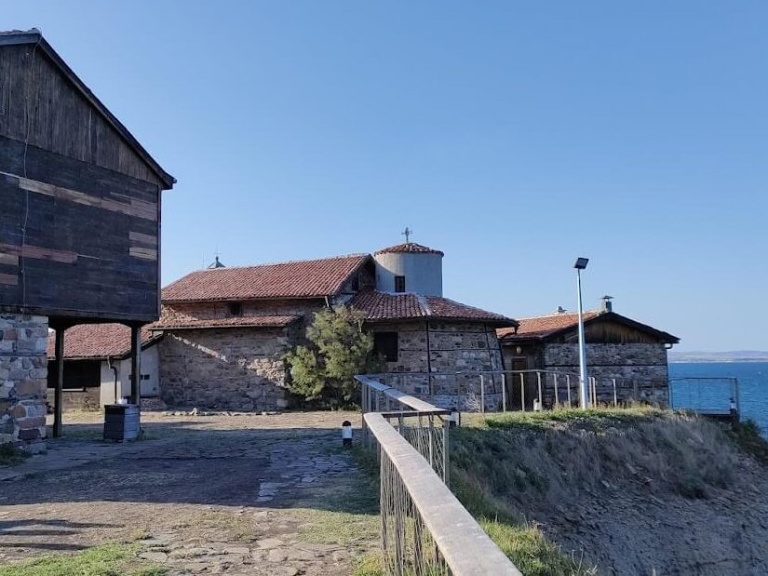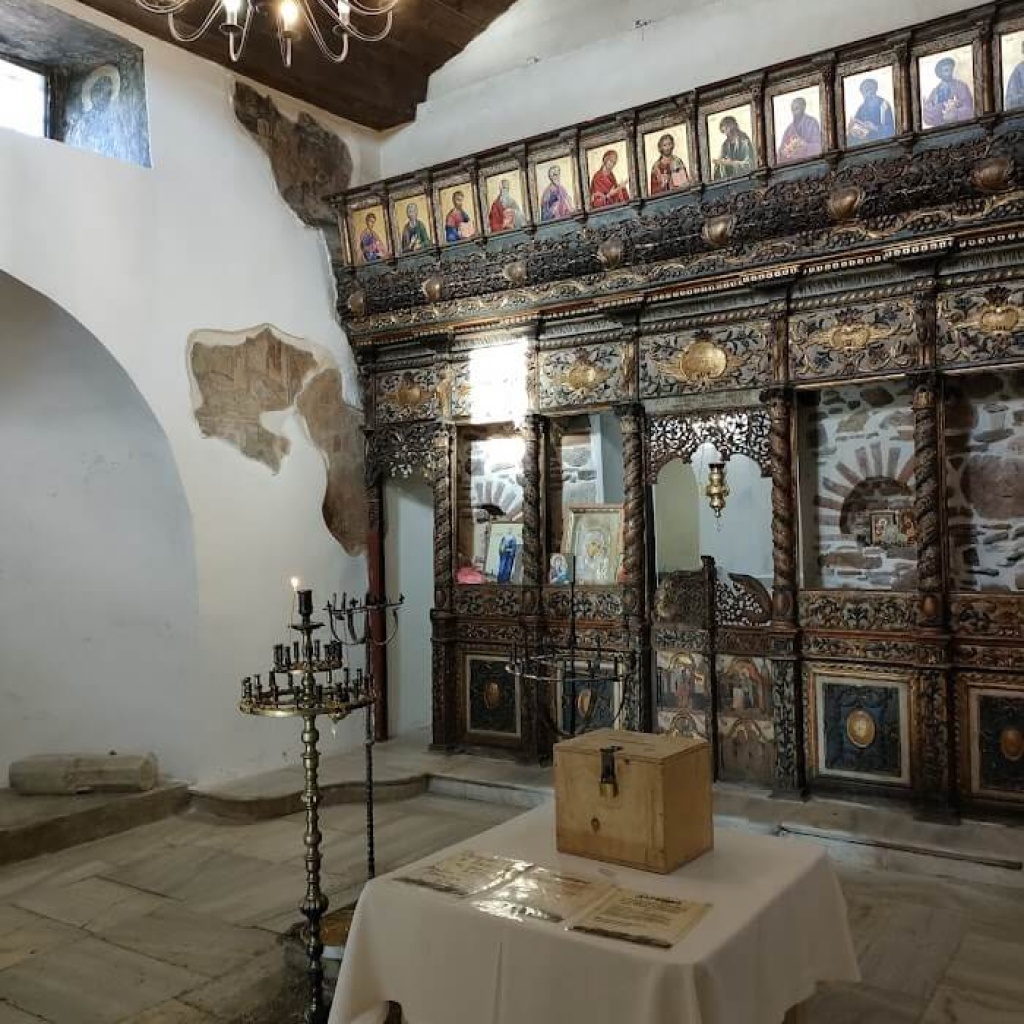St. Anastasia Island: The Bulgarian Alcatraz8 min read
Four miles (6.5 km) southeast of Burgas, in the gulf of the same name, lies St. Anastasia Island, the only habitable island on the Bulgarian coast. Some artefacts found in 1973, including an ancient amphora from Constantinople, allow us to date the first human settlements on the island to the 4th-6th century AD.
Of volcanic origin and with an area of only 0.01 square kilometres, the islet appears for the first time at the end of the 17th century on a map by the Dutch cartographer Nicolaes Witsen. Shaped by the turmoil of history and sea storms, the so-called “Bulgarian Alcatraz” has been the scene of assaults, fires, film sets, imprisonments, and daring escapes

St. Anastasia under the Ottoman Empire
The name of the island derives from the monastery that stands there, dedicated to the Roman martyr Anastasia Farmacolitria (“Healer from poisons” in Greek), who was burned alive in 304 AD in Sremska Mitrovica, Serbia. The oldest document that testifies to the presence of a religious community on the island dates back to 1575 and refers to two monks. In 1623, when the Cossacks and the Ottomans occupied and destroyed the monastery of San Giovanni Battista in Sozopol, part of the surviving religious community moved to the island of St. Anastasia. In the chronicles of the Turkish writer Evliya Çelebi, who visited the island in 1656, a “rich monastery” is mentioned.

In 1784, the French officer André-Joseph Lafitte-Clavé participated in a mission to the Ottoman Empire on behalf of his country and found legions of Turkish soldiers stationed on the island to fend off possible attacks by the Russian fleet. St. Anastasia had in this way been converted into a strategic base for the Turkish artillery, as evidenced by the iron cannons later found in its territorial waters. With the liberation of Bulgaria from Ottoman occupation at the end of the 19th century, a small shipyard arose, made up of a small fleet dedicated to fishing and transport, as well as a windmill: all owned by the monastery, rebuilt and renovated thanks to donations and the patronage of a wealthy Burgas family after the various attacks and fires suffered at the hands of pirates over the centuries.
Escape from Alcatraz (Bulgarian)
In July 1923, a coup d’état supported by Tsar Boris III and favoured by the neutral position of the Bulgarian Communist Party (BKP) overthrew the executive led by the Bulgarian National Agrarian Union and its leader Aleksandar Stamboliyski. A repressive right-wing government was established, headed by Aleksandar Tsankov. The monastery of St. Anastasia becomes a prison in which political opponents — including 132 landowners and communists — are sent to solitary confinement. However, the maintenance and control of the prison was too complicated, and the prisoners were soon transferred back to the mainland, in Burgas, and partially released.
Following a bloody Communist attack on Sveta Nedelya Cathedral in the capital of Sofia in April 1925, the islet again became a very crowded detention camp. In July of the same year, 43 political prisoners organised their escape a few days before the trial that would have sentenced them to death. They manage to flee aboard two rowboats to Nos Chukalya, a promontory south of Burgas, later reaching Istanbul by land. On 17 August they embarked on board the Soviet ship Ilyich, bound for the USSR. In the 1940s, however, a large part of the fugitives ended up victims of Stalinist repressions and were interned in Siberia, from where they would never return.
Meanwhile, the monastery on the island of St. Anastasia never completely ceased to be a place of exile and imprisonment. From July to October 1941, it was officially transformed into an anti-fascist camp, with 63 prisoners. Finally, on 9 September 1944, a new coup d’état shook the country and power passed into the hands of the Communists who, in honour of the July 1925 escape, decided to rename the island from St. Anastasia to Bolshevik, a name it would keep until 1991. Bolshevik Island was declared a “historic place of the revolutionary struggle” and accompanied by plaques in memory of the prisoners.


From the postwar period to the present day
In the 1960s, a museum exhibition dedicated to the events of 1925 was organised on the island, and a building adjoining the monastery was converted into a hotel. Bolshevik Island becomes the refuge of the Burgas intelligentsia — actors, directors, writers — who go there in search of inspiration. The most famous guest is probably the poet Hristo Fotev, who, due to his profound attachment to the maritime city, was even nicknamed “governor of the island”. Among his most famous verses there is undoubtedly the poem “Is the sea a fiction?”:
Измислица ли е морето?
И щастието ли? Не вярвайте!
Не вярвайте на капитаните,
които го продадоха!
Не вярвайте и на проститутките
които го забравиха!
Не вярвайте и на поетите
които го изгубиха!
Не е измислица морето
и щастието съществува!
Достатъчно е да се вслушате
във тишината на сърцето си.
Достатъчно е да протегнете
ръката си, да се усмихнете
на някого и да му върнете
отнетото от капитаните
и проститутките –
о, мъничко
от вярата си във дърветата,
във най-щастливите предчувствия,
във поздравите на другарите,
във делниците и светкавично
вий ще намерите морето…
Най-синьото и най-лъчистото
ще се усмихне във очите ви.
И портокаловото слънце
ще ви замести капитанската
фуражка, капитане мой!
Здравейте, капитане мой!
Не е измислица морето
и щастието съществува!
Is the sea a fiction?
And happiness? Don’t believe it!
Don’t trust the captains,
who sold it!
Don’t trust prostitutes either
who forgot it!
Don’t believe the poets either
who lost it!
The sea is not fiction
and happiness exists!
It is enough to listen
in the silence of your heart.
It is enough to stretch
your hand, to smile
to someone and give them back
taken away by the captains
and prostitutes —
Oh, little
from your faith in trees,
in the happiest premonitions,
in the greetings of comrades,
in the weekdays and lightning fast
you will find the sea…
The bluest and brightest
will smile in your eyes.
And the orange sun
it will take the place of your hat
as a captain, my captain!
Hello my captain!
The sea is not fiction
and happiness exists!

In this same period, the monastic complex was restored several times, while the church of the Virgin Mary underwent only minor renovations: in fact, it is still possible to observe some of the original iconostasis inside. In 1975, Bolshevik Island was connected to the electricity and water systems, and the museum was expanded by an exhibition on the history of the island.
The island was also the set of some films. In 1958, the director Rangel Valchanov set his first feature film On a Small Island (Na malkiya ostrov), inspired by the July 1925 prison break. In 2010, the filmmaker Kamen Kalev chose the island of St. Anastasia for his film The Island (Ostrovăt), starring Laetitia Casta.
At the beginning of the 21st century, St. Anastasia once again aroused interest in institutions and citizens alike. Since 2001, the island has been officially recognized as a place of historical and cultural interest. In 2014, the Burgas region began to invest resources to develop its tourist potential: during the summer season, it can be reached in a few minutes with a ferry that leaves directly from the port of Burgas. On the island, it is possible to visit the museum, the church, go to the beach, sit down to eat, and even stay overnight in one of the cells of the former monastery.


This article was originally published in Italian on 30 June 2023 by our partner Meridiano 13.




